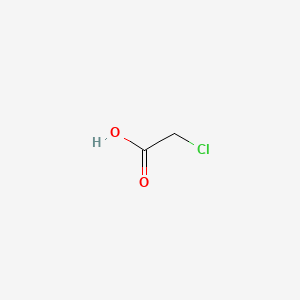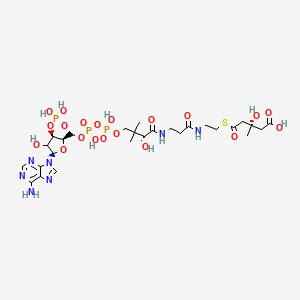Possible associated with:
| Structure | name | description | Reference count |
|---|---|---|---|

|
EPA | Epa is a lipid of Fatty Acyls (FA) class. | 5952 |

|
2-chloro-acetic acid | 2-chloro-acetic acid is a lipid of Fatty Acyls (FA) class. | 574 |

|
6-aminohexanoic acid | 6-aminohexanoic acid is a lipid of Fatty Acyls (FA) class. 6-aminohexanoic acid is associated with abnormalities such as Blood Clot, Myocardial Infarction, Cerebrovascular accident, Renal impairment and Scoliosis, unspecified. The involved functions are known as Fibrinolysis, Agent, Hemorrhage, plasminogen activation and inhibitors. 6-aminohexanoic acid often locates in Chest, Blood, Body tissue, peritoneal and Plasma membrane. The associated genes with 6-aminohexanoic acid are P4HTM gene, BSND gene, MTPN gene, NDUFS4 gene and Homologous Gene. The related lipids are Phosphatidylserines and Butyric Acid. | 3685 |

|
HMG-CoA | Hmg-coa is a lipid of Fatty Acyls (FA) class. Hmg-coa is associated with abnormalities such as Cardiovascular Diseases, Hypercholesterolemia, Metabolic Diseases, Hyperhomocysteinemia and Morphologically altered structure. The involved functions are known as ketone body biosynthetic process, Regulation, Mutation, enzyme activity and HMG-CoA synthase activity. Hmg-coa often locates in Mitochondria, Cytoplasmic matrix, Hepatic, Membrane and Flank (surface region). The associated genes with HMG-CoA are Human gene, HMGCS2 gene, PPARA gene, ACSL1 Gene and Candidate Disease Gene. The related lipids are Fatty Acids, Sterols, Dehydrocholesterols, Lipopolysaccharides and 7-dehydrocholesterol. | 355 |

|
tacrolimus | Tacrolimus is a lipid of Polyketides (PK) class. Tacrolimus is associated with abnormalities such as Renal glomerular disease. The involved functions are known as inhibitors, Fungicidal activity, Metabolic Inhibition, Excretory function and Dephosphorylation. Tacrolimus often locates in Hepatic, Mitochondrial matrix and Inner mitochondrial membrane. The associated genes with Tacrolimus are RHOA gene and BGN gene. | 12730 |

|
erythromycin | erythromycin is a lipid of Polyketides (PK) class. Erythromycin is associated with abnormalities such as Systemic Inflammatory Response Syndrome, Pneumonia, Infection, Pneumococcal Infections and Exanthema. The involved functions are known as Pharmacodynamics, Sterility, Agent, Drug Kinetics and Adjudication. Erythromycin often locates in Blood, peritoneal, Extracellular, Ribosomes and apicoplast. The associated genes with erythromycin are P4HTM gene, SLC33A1 gene, FAM3B gene, Operon and Homologous Gene. The related lipids are Hydroxytestosterones, Steroids, Propionate, Mycolic Acids and campesterol. The related experimental models are Mouse Model and Knock-out. | 19871 |

|
Azithramycine | Azithramycine is a lipid of Polyketides (PK) class. Azithramycine is associated with abnormalities such as Respiratory Tract Infections, Pneumonia, Lower respiratory tract infection, Infection and Nonspecific urethritis. The involved functions are known as Lysis, Selection, Genetic, Mutation, Relapse and Adaptation. Azithramycine often locates in Blood, Respiratory System, Genitourinary system, Back and Chest. The associated genes with Azithramycine are Genes, rRNA, Genome, RPL22 gene, OPRM1 gene and tryptic soy broth. The related lipids are Liposomes, Phosphatidylserines, Promega, Lipopolysaccharides and Steroids. The related experimental models are Mouse Model, Knock-out and Tissue Model. | 7835 |

|
clarithromycin | clarithromycin is a lipid of Polyketides (PK) class. Clarithromycin is associated with abnormalities such as Helicobacter Pylori Infection, Infection, Coinfection, Gastritis and Peptic Ulcer. The involved functions are known as Point Mutation, Increased Sensitivy, Bacterial resistance, urease activity and Mutation. Clarithromycin often locates in Blood, Gastric mucosa, Biopsy sample, Respiratory System and Entire gastrointestinal tract. The associated genes with clarithromycin are Genes, rRNA, rRNA Operon, Genome, HM13 gene and GDF15 gene. The related lipids are 9,11-linoleic acid, Steroids, Lysophosphatidylcholines, Lipopolysaccharides and 4-hydroxycholesterol. The related experimental models are Mouse Model, Knock-out and Experimental Pneumococcal Meningitis. | 10449 |

|
cholesterol | cholesterol is a lipid of Sterol Lipids (ST) class. Cholesterol is associated with abnormalities such as Trypanosomiasis, Chagas Disease, Cleft Palate, Chondrodysplasia punctata 2, X-linked dominant and Child syndrome. The involved functions are known as Blood Circulation, Sterol Biosynthesis Pathway, Receptor Mediated Endocytosis, Methylation and Signal. Cholesterol often locates in Animal tissue, Blood, Membrane, Plasma membrane and peroxisome. The associated genes with cholesterol are MBD2 gene, SIM, SLC33A1 gene, Genome and NSDHL gene. The related lipids are Sterols, zymosterol, fecosterol, Total cholesterol and 7-dehydrocholesterol. The related experimental models are Mouse Model, Knock-out, Genetically Engineered Mouse and Disease model. | 98461 |
Total
9